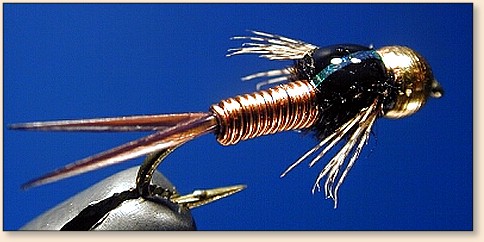|
|
|
||||||||||||||||||||
|
Copper John The Copper John, designed by John Barr of Colorado as a dropper fly for his “hopper-dropper” system, has been described as the hottest nymph pattern in the U.S. That may well be true…I don’t know (or care) what the statistics show. What I do know is that if you talk to anyone who has used this pattern you will most likely find her/him to be a devotee’ of this relatively simple fly. Not only is it a good pocket water searcher, it can function as a midge pattern in smaller sizes when using Chironomid techniques. The original version was tied with regular copper wire, but red and chartreuse are also popular. The best wire to use is Ultra Wire because it won’t tarnish. See Skip Morris’ article on this fly in the latest (summer, 2005) issue of Flyfishing and Tying Journal for additional background information. |
|||||||||||||||||||||
|
Materials
Tying instructions1. Smash the hook barb. Apply the bead, and then wrap the lead/substitute wire around the shank, covering the front ½ of the shank. Push the wire into the rear opening of the bead. When this is done, the wire should cover less than ½ of the shank. Start the thread behind the lead and move it to the point just above the back of the hook barb. 2. Measure two biots to a length equal to 2/3 of the shank, and tie one in on each side of the hook at the same point. Bind the biots down right to the back end of the lead so that a smooth transition is formed. |
3. Tie in a piece of copper wire just behind the lead and wrap back to the tie-in point for the biots. Move the thread forward, covering the shank and wire with a smooth layer of thread to form an even base for winding the copper wire. Leave the thread at the back end of the lead. 4. Wind the copper wire forward in tight turns to the thread, with each turn hard against the last. Tie the wire off at that point. 5. Tie in a strand of Flashabou dead center on top of the thorax, followed by a thin strip of Thin Skin. These should both be pointing to the rear. 6. Tie in 2 or 3 peacock herls at the rear of the thorax area, spin them together with the thread, and wind the rope forward to the bead. Tie it off there and trim the excess. 7. Pull the Thin Skin forward and tie it off behind the bead. Do the same with the Flashabou strand, keeping it dead center on the top of the thorax. Trim the excess on both materials. 8. Cut a small bunch of partridge fibers and tie them in on the far side of the hook just behind the bead. Do the same on the close side of the hook. The legs should extend no farther than the midpoint of the abdomen. 9. Whip finish and trim the thread. Put a tiny drop of epoxy or Hardhead cement on top of the thorax, making sure you don’t let it spill over and soak into the peacock and/or legs. There should be a bit of a “hump” formed by the epoxy or cement, so you may have to apply more than one coat. I prefer the Hardhead cement; it holds up just as well as epoxy and is a whole lot easier to use. |
||||||||||||||||||||
![]()
Copyright 2005 by Granite Bay Flycasters unless otherwise noted.


